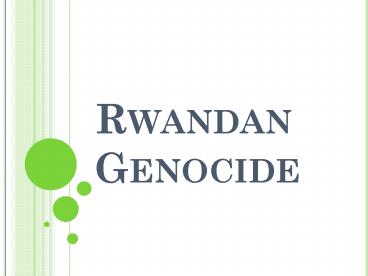Rwandan Genocide PowerPoint PPT Presentation
1 / 12
Title: Rwandan Genocide
1
Rwandan Genocide
2
History of Rwanda
- Majority Hutus (85) and minority Tutsis (15)
lived together peacefully - Hutus farmers
- Tutsis cattle raisers
- Also, Twa indigenous population
- All share common language
- 2.5 million population (2005)
- Most densely populated country in Africa
3
Colonization of Rwanda
- 1894 colonized by Germans
- 1917 given to Belgium after WWI
- Created "Ruanda-Urundi," with Burundi
- Belgians favored Tutsis
- Government issued identity cards to separate
tribes - Gave government jobs and special tax cuts to
Tutsis - Created discontent and resentment
- 1959 Hutu rebels overthrew Tutsi Monarchy
- Bloody hundreds killed
- July 1962 official independence
- Hutus already controlled much of government
- Over next several years, thousands of Tutsis
killed and tens of thousands displaced to Burundi
4
Belgian Rule
The size of the nose and the color of the eyes
were factors that determined whether a person was
classified as Hutu, Tutsi or Twa.
5
Rwandan Civil War
- Tutsi exiles formed Rwandan Patriotic Front (RPF)
- 1990 launched civil war from Uganda
- Rwandan government, led by President Habyarimana
reacted - Targeted killings of Tutsi population claiming
RPF trying to take over and enslave Hutus - Aug. 4, 1992 civil war ended
- Peace agreement in Arusha, Tanzania by both
parties - The Arusha Accord outlined that a new
transitional government be set up, a general
election be held by 1995, and an international
peacekeeping force be deployed.
6
Rwandan Peace Negotiations
- Even though Habyarimana signed accord, he
privately dismissed it - Regularly ordered killing of groups of Tutsis by
secret death guards - Included some members of Presidential Guard
- Also trained popular militia Interhamwe
- Feb. 1993 Despite peace negotiations, violence
flared between RPF and government - Feb. 1993 UN invited by both sides to help
negotiate peace agreements - United Nations Assistance Mission in Rwanda
(UNAMIR) - Led by Canadian Romeo Dallaire
7
Rwandan Genocide
- April 6, 1994 President Habyarimana killed in
plane crash - RPF blamed
- still not clear if RPF or Hutu extremists
- Sparked well planned genocide signal to
Interhamwe to being killings - Hutu government officials called for
self-defense against Tutsi accomplices and
enemies - Used radio and media to promote messages of hate
- Road blocks set up
- Within hours, organized and systematic program
for mass extermination was underway
8
Genocide
- Once genocide began, most of UN peacekeepers
removed because beyond scope of their commitment - 10 Belgian peacekeepers killed
- For over 3 months, Tutsis were hunted tortured
and massacred on the streets, in their homes, in
churches and in schools - Civilians joined in violence
- Used guns and often machetes against their
neighbors - Identity cards that were introduced under Belgian
rule used - RPF invades from Burundi
- Over 2 million Hutus flee to Zaire fearing
attacks from RPF - UN responds with limited troops and humanitarian
aid - Problem French troops had provided arms to
government, so majority of Rwandans distrustful
9
Rwandan Genocide
- By July, RPF taken control of Kigali (capital)
- Ended genocide
- Around 800,000 Tutsis and moderate Hutus lost
their lives in 100 days (1/10 of population)
10
Refugees
Rwandan refugees tried to escape the horrors of
the genocide by going to Tanzania, but were
turned back by at the borders by Tanzanian
soldiers.
11
International Response
- Policymakers in France, Belgium, the United
States and the United Nations were aware of the
preparations for systematic extermination but did
not to intervene - The U.S., attributing the massacres to "tribal
warfare," instructed officials not to use the
term "genocide" - 1994 - International Criminal Tribunal for Rwanda
set up to prosecute those who bear the most
responsibility for genocide, crimes against
humanity, and other serious violations of
international humanitarian law - So far, 17 people convicted, 24 currently on
trial and 22 awaiting trial - Also local courts trying perpetrators
- Gacaca - direct participation of each member of
the community in confronting, rehabilitating and
reintegrating accused perpetrators into the
community
12
Lessons
- 1999 Independent inquiry into events
- UN Secretary General Kofi Annan, We will not
deny that, in their greatest hour of need, the
world failed the people of Rwanda" - Resulted in international calls for a system to
identify potential genocides in their earliest
stages and intervene so that what happened in
Rwanda never happens again

